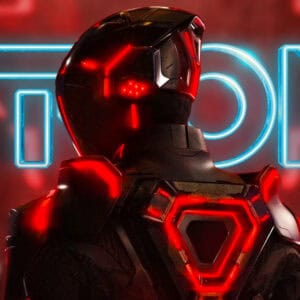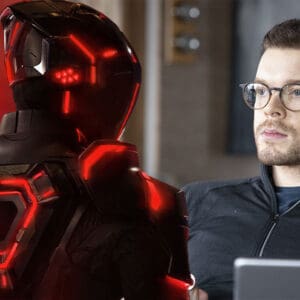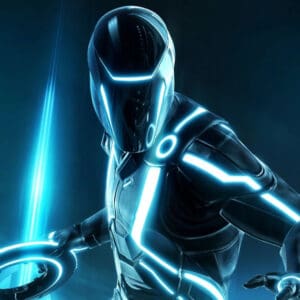Last Updated on August 5, 2021

As every fanboy knows, TRON: LEGACY comes out tomorrow. I recently got to speak with writers Edward Kitsis and Adam Horowitz about the film. I’ve loved the original TRON since I first saw in in my footy pajamas all those years ago, and I was really curious about the process of following something up almost three decades later. Kitsis and Horowitz told me about their original pitch, working with director Joe Kosinski (who they love to watch as he watches television) and how one writes for a film with so many effects.
Edward Kitsis and Adam Horowitz
Did your heads just explode when you found out you would be writing the sequel to TRON? I mean, it’s the holy grail for fanboys.
Edward Kitsis: Yes. I keep using this metaphor, but it’s like being a fan of the Rolling Stones and then having Mick call you and saying, ‘Do you want to play in the band?’ and getting to be on stage. That being said, the minute we got the job, it was completely terrifying because as fans of TRON, we knew what we would say if TRON was announced. ‘You’d better not screw it up.’ For three years it’s just been pure terror and panic because we knew we had so much to live up to.
Adam Horowitz: It was daunting and overwhelming and exciting and terrifying and all these things at once, but it was the opportunity of a lifetime and we couldn’t have been more thrilled to get the chance to take a crack at it.
I’m curious about the whole chicken/egg thing. You come up with a story but you don’t know how much money you’re going to have for effects. At what point did that all start to come together.
Horowitz: When we came up with our pitch for the movie, that’s when a writer has no worries about budget or any of that. We can just kind of come up with what we think is the best story possible and that is what we pitched. And we were very lucky to then be partnered with producers like Sean Bailey and Justin Springer and a director like Joe Kosinski who is brilliant. They all said, we can do this. And once they said that, we were just free to all collectively collaborate and create and do whatever we wanted to tell the story we wanted to tell.

At what point did you know about the extent of the CGI that would be used on Jeff Bridges?
Horowitz: Well, our initial pitch was…
Kitsis: That’s the pitch that got us the job. Our initial pitch was two Jeff Bridges. We pitched the idea that we wanted to tell a father/son story and we were like, what is a way to do that that’s interesting? The world of TRON…we were thinking about what is unique in this world. And we realized that you could do in this world…you can have a thirty-five-year-old version of Jeff and a current version of Jeff, both dealing with a son. So basically you have Kevin Flynn dealing with two sons and a son dealing with two fathers.
Horowitz: He’s got another son who’s also a version of himself that he’s grown from. And now he realizes that version had his priorities wrong and the way that he looked at the world was wrong. And that’s his fault. That’s what we love about it. And that version of himself doesn’t understand what he did wrong and why his father abandoned him. And that’s what makes the villain so tragic. You know? That was our first idea and we didn’t even know if it was possible and Jo Kosinski said, ‘Oh, that’s possible.’ And Joe did a lot of research and worked with it and brought it to life.
I always like to ask writers about what action scenes look like on their pages. I mean, these aren’t your run of the mill fights. There are light cycles and flying discs…
Horowitz: It’s an incredibly detailed process, and with TRON, we would write a version of a scene and give it to Joe, and then Joe would give us his thoughts about what he would want to do with the scene. And then he would give us pre-vis for the scene or sketches of environments. So we would go back and forth, so it would keep evolving.
Kitsis: By the way, he would work with his artists and they would block it. So by the end of it, it would literally be pre-vised, and then you would go back and add detail so everyone understands it more. So that’s what’s so great about working with a director, is that you really get to work together on these things. So we might be…Joe would be like, ‘I think the disc games should have these undulating platforms.’ And we’d say, ‘What if Sam jumped off one. What would they do?’ And then you’d see the sketch and you’re like, ‘Oh, okay.’ We can’t say enough about Joe Kosinski. He’s a visionary. That’s the only way to describe him. We always say he’s come from the future to show us how to use technology.
Horowitz: It’s kind of true. I mean, I remember we were having a story meeting and we all took a break for dinner, and we were just watching TV. Just watching him watch TV…it’s like he’s seeing things that you’re not. He knows if this color is off a shade because he can see it. And you’re like, ‘Okay, yeah…’
Were there ever any story changes involving things that you couldn’t do? Effects are expensive.
Horowitz: There is always compromise. Sometimes you find a location that the house is different than you did it and you change it.
Kitsis: Yeah, I mean it’s one of the things that working in television for a number of years really taught us. How to adapt for production so that you can try and successfully keep what you want in every scene within the production budget.

Was there anything you saved for a sequel?
Kitsis: Look, we’re writers. And we came from TV so we’re always thinking about what’s next. As far as the movie goes, we wanted to tell a complete story and have the audience be able to leave satisfied. If they feel strongly enough about the movie that they want another one, then we would be happy to dive in.
Horowitz: [laughs] We have some thoughts.
Kitsis: The great thing about TRON and the franchise is that there are lots of different stories happening on the grid. You saw one last night, but when the Recognizer flew over the city, you saw other sectors. So there are different ways to tell different stories about different parts of the world. That’s why the animated show that we’re doing for Disney is great, and the graphic novels and the video games. For us it’s great because that’s what was so much fun about these things when we were young. As storytellers, you want to tell stories in different ways, but some don’t want to be a movie. They want to be a TV show. Some stories want a five minute thing on the internet.
Well, this one is certainly a natural transition into a game. [laughs] It’s TRON.
Kitsis: Yeah, the ANNIE HALL video game was not very good. [laughs]
When you were breaking the story, how did you decide which characters to bring back…no Cindy Morgan?
Horowitz: Well, you have two hours and some characters are essential to the story. You have to pick and choose what’s going to tell your story. And certain characters fit in exactly in the paradigm of what you’re trying to do and that’s what you have to stick to. It’s very easy to walk into a toy store and want every toy in the store. But you have to be disciplined and say that, to have a story that makes sense, you can’t go off on a tangent.
I also wanted to ask you about the concept of ISO’s.
Horowitz: What we always say is that the idea of an evolution to the grid was something that was one of the first notions we played with, which is, what happens twenty-eight years later with the advances in technology? What would that mean? We always talked about things like Moore’s law, where technology keeps doubling at an exponential rate. What would that mean? We were very drawn to the idea that the programs since the first movie would be different. They would start to…
Kitsis: We always wanted to do programs that were more human-like. We wanted to see the evolution of that…in the End of the Line Club scene, one of my favorite things is when Sam sees the guards and she goes, ‘They’re busy.’ It’s just great! There are two guards hanging out, having fun. To us that is like…that’s really cool.
TRON: LEGACY will be released in theaters on Friday, December 17th. As if you didn’t know.




















Follow the JOBLO MOVIE NETWORK
Follow us on YOUTUBE
Follow ARROW IN THE HEAD
Follow AITH on YOUTUBE